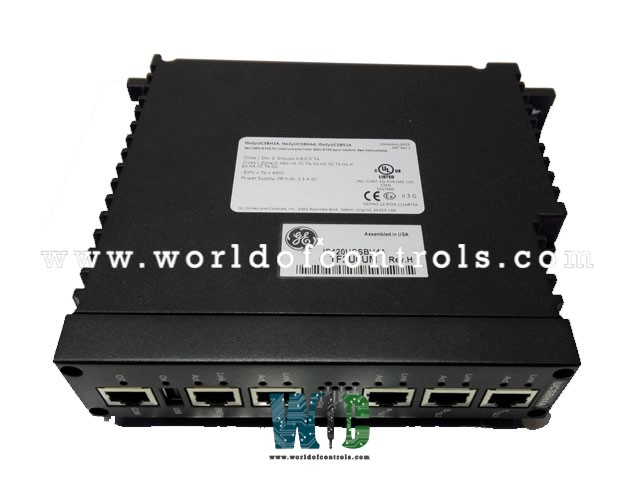
World Of Controls understands the criticality of your requirement and works towards reducing the lead time as much as possible.
IS420UCSBH4A, REV E is available in stock which ships the same day.
IS420UCSBH4A, REV E comes in UNUSED as well as REBUILT condition.
To avail our best deals for IS420UCSBH4A, REV E, contact us and we will get back to you within 24 hours.
SPECIFICATIONS:
Part Number: IS420UCSBH4A, REV E
Manufacturer: General Electric
Country of Manufacture: United States (USA)
Series: Mark VIeS
Function: UCSB Controller
Microprocessor: 600MHz Intel
Memory: 256 MB DDR2 SDRAM
I/O Network Support: R, S, T IONets
Operating System: QNX Neutrino
Programming: Boolean
Primary Ethernet Interface: 10Base-TX/100Base-TX,
Weight: 2.4 lbs
Availability: In Stock
Manual: GEH-6721_Vol_II
FUNCTIONAL DESCRIPTION:
IS420UCSBH4A, REV E is a UCSB Controller Module manufactured by General Electric as part of the Mark VIeS Series used in gas turbine control systems with a 1066 MHz Intel EP80579 microprocessor. The UCSB controllers are standalone computing units that execute application code independently. Designed for panel mounting, these controllers connect to I/O packs via built-in IONet interfaces. IONet is a dedicated, proprietary Ethernet network specifically developed to support only Mark Controls I/O modules and controllers. The controller runs on the QNX Neutrino operating system�a real-time, multitasking OS engineered for high-speed and highly reliable industrial operations. Unlike conventional controllers that integrate I/O modules through a backplane, the UCSB controller does not directly host any application I/O.
All I/O networks are connected to each controller, ensuring they receive complete input data. The hardware and software architecture is designed to eliminate any single point of failure�input data remains available even if one controller is taken offline for maintenance or repair. The Mark VIeS UCSBSIA Safety Controller, along with Safety I/O modules, supports functional safety loops and enables compliance with SIL 2 and SIL 3 requirements. This safety equipment is intended for use by operators experienced in safety-instrumented system (SIS) applications, helping to mitigate risks in critical safety functions. Both the safety controllers and distributed I/O modules are purpose-built and programmed specifically for safety control and are certified to IEC 61508 standards. The UCSB Controllers offer the Following Advantages:
UCSBH4A INSTALLATION:
The controller is enclosed in a compact, single-module design that mounts directly onto the sheet metal of a control panel. This streamlined form factor simplifies installation and conserves space within the cabinet. Detailed dimensional drawings, provided below, specify the module�s envelope and mounting requirements, with all measurements listed in inches for clarity and precision.
To ensure proper operation and long-term reliability, the UCSB controller must be securely fastened to the panel by the recommended mounting orientation. This positioning is critical for maintaining proper vertical airflow through the unit�s integrated cooling fins. Unobstructed airflow is essential for effective heat dissipation, preventing thermal buildup that could affect performance or damage internal components. Installers should avoid placing obstructions near the fins or blocking ventilation paths, as proper cooling is key to supporting the controller's continuous operation in industrial environments.
UCSBH4A SOFTWARE AND COMMUNICATION:
The controller is equipped with specialized software designed to execute both ladder logic rungs and function blocks. It supports online editing, allowing minor modifications to the control logic to be made without interrupting system operation or requiring a restart, enhancing flexibility and reducing downtime during routine adjustments.
Time synchronization between the controllers and I/O packs is maintained with high precision, using the IEEE 1588 Precision Time Protocol (PTP). This ensures all devices remain synchronized within 100 microseconds over the R, S, and T IONet networks. These dedicated IONet connections also serve as the communication backbone for transferring external data between the I/O modules and the controller�s internal control system database. This includes real-time process inputs and outputs, supporting accurate and coordinated control across the entire system.
UCSBH4A BOOT LED:
During the boot process, the controller's boot LED provides visual feedback on system status. Under normal conditions, the LED remains steadily illuminated. If an error is detected during boot-up, the LED begins flashing once per second�each flash consists of a 500-millisecond on-state followed by a 500-millisecond off-state. After completing the sequence, the LED remains off for three seconds before repeating. The number of flashes in the sequence corresponds to a specific error code, helping to identify the fault.
If the flash image is valid but the runtime firmware has not yet been loaded, the boot LED will flash continuously at a steady rate. Once the firmware is successfully loaded, the LED turns off, indicating readiness.
If the controller fails to come online, the ToolboxST application should be used to diagnose and troubleshoot connection issues. After the controller is assigned an IP address, ToolboxST automatically configures itself over the Ethernet connection, enabling further setup and monitoring.
WOC has the largest stock of Replacement parts for GE Distributed Turbine Control Systems. We can also repair your faulty boards and supply unused and rebuilt boards backed up with a warranty. Our team of experts is available around the clock to support your OEM needs. Our team of experts at WOC is happy to assist you with any of your automation requirements. For pricing and availability on parts and repairs, kindly contact our team by phone or email.
Which operating system is used, and why?
The controller operates on QNX Neutrino RTOS, a POSIX-compliant, microkernel-based real-time operating system. It ensures high determinism, low latency, and robust fault isolation�critical for safety and mission-critical industrial automation.
How is input/output data acquired and shared?
Data is acquired via IONet (R, S, T)�a dedicated GE-specific Ethernet protocol that connects the controller to I/O packs. All input data is mirrored across these networks, enabling fault-tolerant data acquisition and distribution.
What communication protocols are supported by the UCSB controller?
While the UCSB uses IONet (a GE-specific, Ethernet-based protocol) for controller-to-I/O communication, other communication paths can support Modbus TCP/IP, PROFINET, or OPC UA via external gateway modules. IONet does not support standard Ethernet traffic, ensuring secure, deterministic performance.